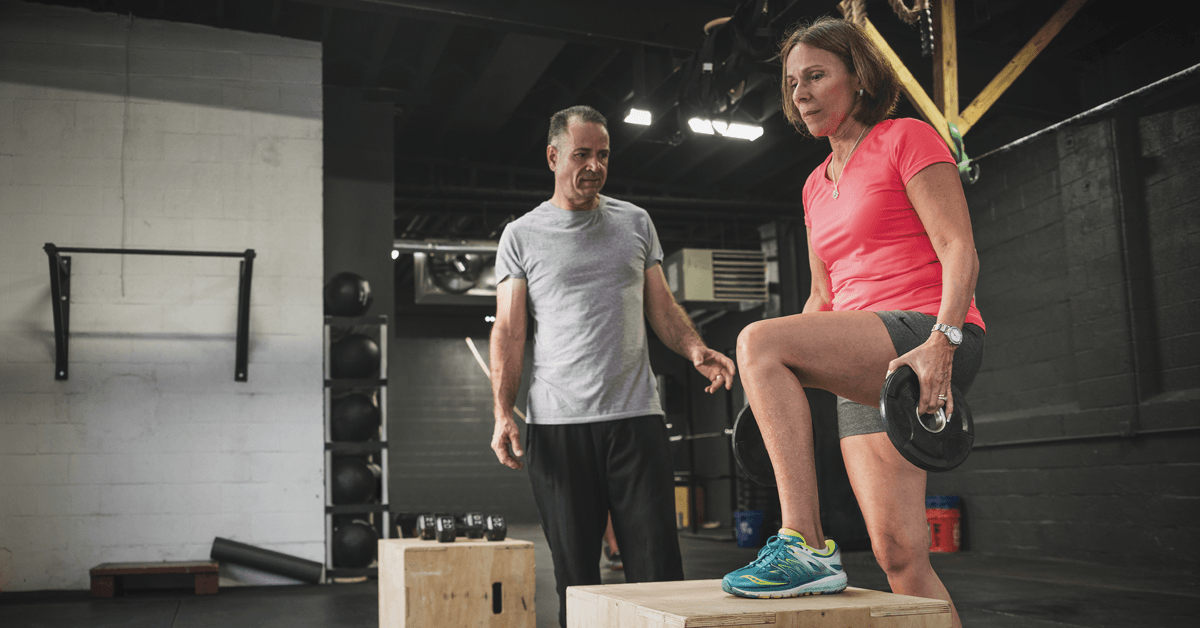The ability to teach proper strength training techniques to a complete beginner has never been more important than it is right now.
Despite the fact that an estimated 60 million people in the U.S. belong to gyms, and plenty of others have access to equipment at home, school, or work, there are still many millions more who’ve never touched a weight with the goal of training with it. Many have never stepped inside a commercial health club. Some of them will be your clients.
If you can master the skill of training novices, and build a reputation on it, your client roster will always be full. And many of those clients will stay with you throughout your career.
Why beginners need strength training
Most beginners will come to you with the goal of losing weight, and may be somewhat skeptical when you make resistance training a priority. Indeed, the calories a novice lifter burns during and after a workout will be negligible.
The biggest selling point is the real-life application of the strength and movement skill your client builds in the weight room. Consider a client who has young kids. What does she do every day? Picks up her kids and carries them. Hip hinges and loaded carries are directly relevant to her life.
What do all your clients do? They climb stairs and carry things, often at the same time. They sit down and get back up. Resistance training makes all those things easier, and when they’re easier, your clients will do them more, with less pain or discomfort.
The better you spell out the real-life benefits of strength training, the more value your clients will place on their fitness program.
READ ALSO: Functional Training for Older Clients
How beginners are different
For many beginners, the usual strength-training rules don’t apply.
Why? One word: adaptation. Our bodies adapt to our regular habits and routines. It’s part of being human. When training a beginner, you’re likely working with a body that has adapted to the postures and shapes of sedentary life. And reversing that acclimation is not going to be easy.
Consider the squat. It’s a fundamental human movement, and one of the most powerful strength-building exercises you can do. Not only does it work the entire lower body, it can even reduce lower-back and knee pain when done correctly. Everyone should be able to squat.
But the reality is, many of your clients are already exposed to hip flexion all day. People sit on their commutes, at their jobs, at mealtimes, and while binge-watching Netflix. If they’re side sleepers (most are), their hips may be flexed all night.
Clients like this don’t need more hip flexion. They need the antidote: hip extension, with movements such as deadlifts and glute bridges.
Treat training as the antidote to the client’s life. Create a program that helps counteract the negative effects of your client’s lifestyle, not reinforce them. Address those muscle imbalances and mobility issues first. You can always put more emphasis on the squat later.
READ ALSO: Why People Must Squat Differently
QUICK TIP: Use assessments to determine your client’s capacity. Here’s a good one to check if he’s ready for rotational work: Have your client assume a pushup position, lift one hand, and touch his opposite elbow. Can’t do it without shifting his weight or rotating his hips? Skip the core rotation moves until he can.
Why some new clients may not need weights right away
Moving an object requires force, and force requires tension in the muscles and connective tissues. But many of your novice clients won’t be able to generate tension and apply it to the movement patterns we use in the weight room.
It’s easier to learn how to create tension—to develop what I call the skill of strength—without the distraction of weights. The next step is grooving the pattern. Only then do we need to add some form of external resistance.
Here’s an example: Hold your client’s wrists as she pulls her arms down, mimicking the lowering phase of a bench press. On the raising portion of the move, push down on her fists.
You can do this with almost any traditionally loaded move. Find a way to create tension throughout the range of motion. (We use a technique called positional isometric training.) This allows your client to get a feel for the movement pattern before adding weight.
What exercises should a beginner do?
Great results start with quality movement. Movement affects joints, muscle growth, cardiovascular fitness, sleep quality, stress management—you name it. It’s the foundation for everything.
For beginners, I like to focus on primal movements:
- Hip hinge
- Lunge
- Step-up
- Push
- Pull
- Carry
READ ALSO: Four Movement Patterns Your Clients Need to Master, at Every Age
The best training method for beginners
My go-to method for beginners is peripheral heart action (PHA) training. By alternating upper- and lower-body exercises performed at medium intensity with no rest, the training style offers a few benefits for beginners:
- It teaches full-body tension.
- It’s not too intense.
- The lack of rest between exercises means sessions are shorter, and clients will feel like their time is being used productively.
It’s also effective: A small 2015 study in the European Journal of Applied Physiology found that subjects who trained this way for three months improved their VO2 max by 8 percent—higher than that reported in traditional resistance training studies. Other markers, including strength, heart-rate variability, and systolic blood pressure, improved just as much or more compared with results seen by subjects in a HIIT group.
Six to eight exercises per session should be plenty.
How many sets and reps should a beginner do?
Beginners tend to have poor work capacity, which means you can accomplish a lot with a relatively low volume of training.
So instead of three sets, start with just one. A Journal of Strength and Conditioning Research review found that for untrained individuals, single-set programs show gains similar to those of multi-set programs during the first few weeks.
Focus on grooving the movement patterns and helping your client understand what she needs to do outside the gym with nutrition, sleep, and physical activity to reach her goals.
As for reps, go with however many the client can do at an intensity level that’s about 55 to 65 percent of her one-rep max. That could be anywhere from eight to 15 reps, depending on the client and the exercise.
Sample strength training routine for beginners
Perform the following moves sequentially, with no more than 30 seconds of rest between them.
Exercise |
Sets |
Reps |
Tempo |
Progression
|
| 1a. Kettlebell deadlift | 1-2 | 12-15 | Slow | |
| 1b. Seated row (neutral grip) | 1-2 | 12-15 | Slow | |
| 2a. Lateral step-up | 1-2 | 8-10* | Medium | Add dumbbells |
| 2b. Alternating bench press (see note above about using manual resistance) | 1-2 | 10-12* | Medium | Add dumbbells |
| 3a. Reverse lunge | 1-2 | 8-10* | Medium | Add dumbbells |
| 3b. Standing face pull (high pulley, pronated grip) | 1-2 | 10-12 | Medium | |
| 4a. Bird dog | 1-2 | 5*^ | (See below) | |
| 4b. Farmer’s walk | 1-2 | 30 seconds | Medium |
* Each side
^ Hold each position for 5 seconds, with perturbations.
Workout frequency
A novice client can easily do this relatively short workout three times a week. Because you aren’t chasing fatigue, there’s plenty of time to recover between workouts.
QUICK TIP: Set the client up to win by breaking big moves down into small, incremental steps. For example, you’d almost never teach the deadlift with the bar on the floor. Start with the regression—in this case, lifting the bar or kettlebell from a box or step. Let your client master the regression, and give him a high-five when he nails it. Celebrating small successes now helps build confidence for bigger victories later.
READ ALSO: 11 Simple Ways to Become a Better Teacher
What’s different for women?
Men and women should have equal success with this program. But there is one small difference: Women tend to recover more quickly than men, which means your female clients may need less downtime between sets.
Conversely, an especially deconditioned client, or one recovering from an injury or illness, will need more time between sets, regardless of gender.
Final tip
Beginner clients typically don’t prioritize themselves. That’s why they’ve waited so long to get serious about their fitness.
To help them reach their goals, be genuinely curious about their lives. Find out who or what motivates your client, and tailor your motivational message accordingly. So your line for new moms might be something like this: “Your family is really lucky to have you setting such a great example.”
Progression in your workouts might come fast or slow. But what matters most for their long-term success is progression outside the gym. You can’t control it, but you can certainly encourage it.










